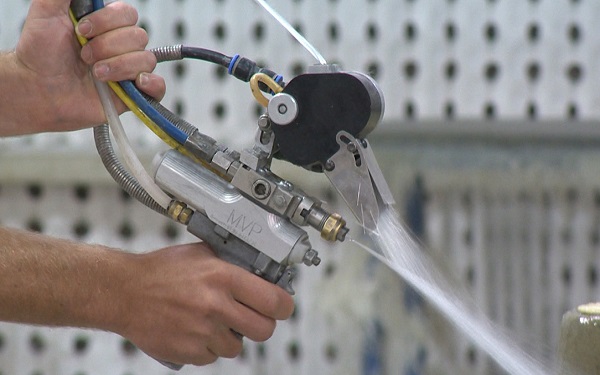Precision, speed, and consistency are the most important criteria in composites manufacturing. Industries such as marine, aerospace, automotive, and construction use the best fiberglass application systems available to meet production schedules and guarantee structural integrity. Fiberglass Chopper Systems are among the most trusted tools in this area, especially when being employed with advanced solutions like ATLAS 3.7 GPM and fiberglass strand choppers.
What Are Fiberglass Chopper Systems?
Fiberglass chopper systems are the specialized means of establishing reinforced plastic components. The system chops continuous strands of fiberglass roving into predetermined lengths and comprises a uniform spray pattern, usually with a resin matrix. The end result is a consistent, reinforced layer which adds to the strength, durability, and overall performance of a product.
Chopper systems are generally employed in areas where manual layup techniques are jumped-up or just inconsistent. Boat hulls, storage tanks, or custom-molded parts; whatever you are making, a chopper system will provide faster and still uniform application, allowing for better quality and forum costs.
Setting Power and Precision: Enter the ATLAS 3.7 GPM
As far as fiberglass applicator systems go, the ATLAS 3.7 GPM stands out among its peers. This unit was built to satisfy the demanding application of high-output production lines allowing up to 3.7 gallons per minute (GPM), a boon to the large-scale composite manufacturer.
What Does a Fiberglass Strand Chopper Do?
A fiberglass strand chopper is a critical part of the complete chopper system. It serves to chop these endless strands of fiberglass into small lengths that are easier to distribute evenly over a mold or surface. The cutting has to be quite precise—if they are too short the whole thing loses a lot of strength, but if they are too long, it is a very inconsistent formulation of the resin mix from one place to another.
State-of-the-art choppers for fiberglass strands come with adjustable cut lengths, powerful cutting blades, and are designed to integrate with spray systems. They are engineered to handle several different types of roving, from normal E-glass to other technical styles. These choppers ensure that the fiberglass reinforcement has an equal size and is distributed everywhere, which is the most critical factor in achieving homogeneous thickness in the final product and mechanical hauling properties.
Why Invest in Quality Chopper Systems?
The reliability and performance of any tool determines to a very large extent the quality of output in the composites industry. A high-performance fiberglass chopper system—especially those using A,ATLAS 3.7 GPM, precision fiberglass strand choppers—gives consistency, reduces wastage, and lowers labor costs. These systems command a worthy return on investment, whether it is for scale-up of production or enhancement of product quality. Flexibility across various sectors also makes them a good option for manufacturers seeking to remain competitive in a rapidly evolving market.
Closing Thoughts
Application equipment is becoming even more important as composite technology evolves. A fiberglass chopper system powered by robust units such as the ATLAS 3.7 GPM and high-efficiency Fiberglass Strand Chopper allows manufacturers to deliver products that meet the quality required in their respective industries. Such an investment is not just a matter of convenience but a commitment towards producing durable, high-performance products that stand the test of time.


